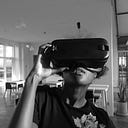An Experimental VR Photo Experience
An American Dilemma, Revisited
An “American Dilemma, Revisited” is a project by American photographer, Andrew Reneissen. The project is introduced by him as below:
In 1944 Gunnar Myrdal, a Swedish sociologist, published the book ‘An American Dilemma’. Myrdal argued America’s dilemma was the contrasting ideals of justice and equal opportunities, on which America was founded, compared to the racial inequality faced by Black America at the time. Myrdal attempted to trace discrimination and show its effects on society.
Since 2011, I have been photographing violence, poverty and racial disparity in cities throughout the United States. The dilemma that Gunnar Myrdal argued, in his book from the 40s, is still evident today in many aspects of black life. A disproportionate number of deaths, a growing wealth gap, inequalities in employment, the criminal justice system and education are all problems constantly faced by African American communities living in America. The paradigm of inequality continues to become normality in the United States, often considered one of the greatest countries in the world. This dilemma incites violence and unrest that create lasting physical and psychological effects on many. ‘An American Dilemma, Revisited’ is a document of those who live in this current state of inequality.
I was moved by the focus of his work and the importance of his photography in America — especially now. The honest documenting of black lives in America is necessary if America is to understand how to face its racial problems, rooted in a long history of neglect for black lives.
Andrew and I become fast friends while living in Nairobi. I asked him if he’d mind if I experimented using his photos to create some sort of VR experience for users to engage with them. I’ve wanted to play with the museum/photographic experience for a while and thought this would be a cool project to start with. He very kindly said yes!
The Experience
Using iTween, I created a navigation system that takes the user through a cuboid museum. The walls are filled with enlarged photos from the collection and in the center of the room are smaller 2D photos with the description beneath them.
The initial movement is in a straight line. The camera takes a gradual arc and arrives in front of a photo. When the user is done looking at the photo, she/he presses “next photo” and will move through the photo to progress to the next photo behind it. I liked the idea of the user literally having to go through the photo — it made it even more intense.
After viewing all the photos, the user has the option to “explore the museum”. The photos in the middle of the room disappear and are replaced by blue waypoints. The user can now choose which photos on the wall to look at and navigate as they please. Clicking on a wall photo pops up a text description and double clicking gets rid of it. Throughout the piece, the skybox changes three times using an old skybox blender technique I’ve used before. Check out some screenshots from the experience below:
The real experimentation of the piece revolves around a “black lives matter” sound piece that I created using audio from YouTube videos. The audio pieces are taken from news bites, speeches, interviews and phone videos around issues of race, police shootings and black lives matter protests. The material is sensitive as it includes sounds of gunshots and clips about death.
Whilst Andrew’s project is not entirely about the Black Lives Matter movement, I thought it would be interesting to piece together some of the most intense sound clips around the large issue and see how it affects the viewers experience of the photos. When I first tested out the project, I was worried that the audio would be distracting. In some ways, it is. The audio can be overwhelming and you have to think about what to do: listen or read. That said, I found the overall experience more visceral with the audio included. It really drives the message about about how the lives of black people in America are being undervalued.
If you’d like to hear to the audio piece, it’s an 8-minute bit on sound cloud below.
How to experience it:
I created this project for Google VR and WebVR using Mozilla’s new asset package. This was my first time using and deploying with Mozilla’s WebVR package. It’s pretty straight forward and you can find the instructions here if you’re interested in learning how to do so. I then deployed the experience using github pages.
To view, make sure you use a WebVR enabled browser. Chrome technically is not a WebVR enabled browser but I’ve used it before. That said, it’s often glitchy and sometimes doesn’t work. In my view, Mozilla Firefox is the best browser for it.
VIEW EXPERIENCE
Use your mouse to hover and look around the space. Hope you enjoy it! Feel free to reach out to me if you have any trouble viewing the piece — or if you have any thoughts on the experience and want to give me some feedback. You can check out more about the project on my website or on github.
